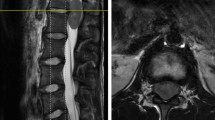Abstract
Background
Surgical removal has been performed as the first line treatment for symptomatic or enlarging hypoglossal schwannomas (HS). Stereotactic radiosurgery (SRS) offers a minimally invasive approach that may afford long-term tumor control for patients with HS particularly those who refuse or are unfit for surgery. This study evaluates outcomes after SRS performed for both newly diagnosed and residual tumors after incomplete resection.
Methods
This retrospective, multi-institutional study involved patients treated with adjuvant or primary SRS for HS. The study end-points included local tumor response, clinical outcomes, and procedure-related complications. All the patients had Gamma Knife SRS.
Results
The cohort included 12 patients (five females), median age at SRS 49.5 years (range, 37–76)]. The median tumor target volume was 5.9 cm3 (range, 0.7–27.23). At median imaging follow-up of 37 months (range, 6–153), tumor control was achieved in 11 patients. Tumor enlargement that was managed with surgical resection was noted at the 6-month follow-up in one patient. At median clinical follow-up of 30.5 months (range, 6–157), stability, or improvement of all pre-SRS signs and symptoms was noted in nine patients. Two patients experienced worsening of at least one pre-existing symptoms or sign. New-onset trapezius weakness was noted in one patient and tongue atrophy in two patients.
Conclusion
Single-fraction SRS appears to be a safe and effective upfront and adjuvant treatment option for HS. SRS may be recommended as an alternative to surgery for patients presenting with HS or as an adjuvant treatment following subtotal resection and at HS recurrence.


Similar content being viewed by others
Availability of data and materials
All the participating centers obtained approval for this study and for the sharing of de-identified data with the IRRF coordinating office by the local institutional review boards.
Abbreviations
- CN:
-
Cranial nerve
- CT:
-
Computed tomography
- GTR:
-
Gross total resection
- HS:
-
Hypoglossal schwannoma
- IRRF:
-
International Radiosurgery Research Foundation
- MRI:
-
Magnetic resonance imaging
- NF-2:
-
Neurofibromatosis 2
- RANO:
-
Response assessment in neuro-oncology
- SNHL:
-
Sensorineural hearing loss
- SRS:
-
Stereotactic radiosurgery
- SRT:
-
Stereotactic radiotherapy
- VS:
-
Vestibular schwannoma
References
Aftahy AK, Groll M, Barz M et al (2021) Surgical Management of Jugular Foramen Schwannomas. Cancers. 13(16):4218. https://doi.org/10.3390/cancers13164218
Bademci G, Yaşargil MG (2006) Microsurgical anatomy of the hypoglossal nerve. J Clin Neurosci 13(8):841–847. https://doi.org/10.1016/j.jocn.2005.12.028
Balossier A, Régis J, Reyns N et al (2021) Repeat stereotactic radiosurgery for progressive vestibular schwannomas after previous radiosurgery: a systematic review and meta-analysis. Neurosurg Rev 44(6):3177–3188. https://doi.org/10.1007/s10143-021-01528-y
Bindal S, elAhmadieh TY, Plitt A et al (2019) Hypoglossal schwannomas: a systematic review of the literature. J Clin Neurosci 62:162–173. https://doi.org/10.1016/j.jocn.2018.11.037
Cavalcanti DD, Martirosyan NL, Verma K et al (2011) Surgical management and outcome of schwannomas in the craniocervical region. J Neurosurg 114(5):1257–1267. https://doi.org/10.3171/2010.5.JNS0966
Dombi E, Ardern-Holmes SL, Babovic-Vuksanovic D et al (2013) Recommendations for imaging tumor response in neurofibromatosis clinical trials. Neurology. 81(Issue 21, Supplement 1):S33–S40. https://doi.org/10.1212/01.wnl.0000435744.57038.af
Elsharkawy M, Xu Z, Schlesinger D, Sheehan JP (2012) Gamma Knife surgery for nonvestibular schwannomas: radiological and clinical outcomes. J Neurosurg 116(1):66–72. https://doi.org/10.3171/2011.8.JNS11215
Fornaro R, Salerno A, Filip D, Caratto E, Caratto M, Casaccia M. Schwannoma of the hypoglossal nerve: review of the literature based on an illustrative case. Mol Clin Oncol. Published online June 21, 2017. https://doi.org/10.3892/mco.2017.1297
Germano IM, Sheehan J, Parish J et al (2018) Congress of neurological surgeons systematic review and evidence-based guidelines on the role of radiosurgery and radiation therapy in the management of patients with vestibular schwannomas. Neurosurgery. 82(2):E49–E51. https://doi.org/10.1093/neuros/nyx515
Goldbrunner R, Weller M, Regis J et al (2020) EANO guideline on the diagnosis and treatment of vestibular schwannoma. Neuro-Oncology. 22(1):31–45. https://doi.org/10.1093/neuonc/noz153
Hayhurst C, Zadeh G (2012) Tumor pseudoprogression following radiosurgery for vestibular schwannoma. Neuro-Oncology. 14(1):87–92. https://doi.org/10.1093/neuonc/nor171
Heiroth HJ, Riemenschneider MJ, Steiger HJ, Hänggi D (2009) A management of hypoglossal schwannomas over 3 decades. Neurosurgery. 65(1):E212–E213. https://doi.org/10.1227/01.NEU.0000347006.02222.CB
Illuminati G, Pizzardi G, Pasqua R, Palumbo P, Vietri F (2017) Schwannoma of the descending loop of the hypoglossal nerve: case report. Int J Surg Case Rep 34:20–22. https://doi.org/10.1016/j.ijscr.2017.03.005
Kimball MM, Foote KD, Bova FJ, Chi YY, Friedman WA (2011) linear management of hypoglossal schwannomas over 3 decades. Neurosurgery. 68(4):974–984. https://doi.org/10.1227/NEU.0b013e318208f3a1
Leon J, Lehrer EJ, Peterson J et al (2019) Observation or stereotactic radiosurgery for newly diagnosed vestibular schwannomas: a systematic review and meta-analysis. J Radiosurg SBRT 6(2):91–100
Nonaka Y, Grossi PM, Bulsara KR, Taniguchi RM, Friedman AH, Fukushima T (2011) Microsurgical management of hypoglossal schwannomas over 3 decades. Oper Neurosurg 69:ons121–ons140. https://doi.org/10.1227/NEU.0b013e31822a547b
Pollock BE, Foote RL, Stafford SL (2002) Stereotactic radiosurgery: the preferred management for patients with nonvestibular schwannomas? Int J Radiat Oncol Biol Phys. 52(4):1002–1007. https://doi.org/10.1016/S0360-3016(01)02711-0
Quant EC, Wen PY (2011) Response assessment in neuro-oncology. Curr Oncol Reports. 13(1):50–56. https://doi.org/10.1007/s11912-010-0143-y
Sarma S, Sekhar LN, Schessel DA (2002) Nonvestibular schwannomas of the brain: a 7-year experience. Neurosurgery. 50(3):437–449. https://doi.org/10.1097/00006123-200203000-00002
Sharma MS, Singh R, Kale SS, Agrawal D, Sharma BS, Mahapatra AK (2010) Tumor control and hearing preservation after Gamma Knife radiosurgery for vestibular schwannomas in neurofibromatosis type 2. J Neuro-Oncol 98(2):265–270. https://doi.org/10.1007/s11060-010-0181-1
Suri A, Bansal S, Sharma B et al (2014) Management of hypoglossal schwannomas: single institutional experience of 14 cases. J Neurol Surg Part B: Skull Base. 75(03):159–164. https://doi.org/10.1055/s-0033-1356924
Tucker A, Miyake H, Tsuji M, Ukita T, Nishihara K, Ohmura T (2007) Intradural microsurgery and extradural gamma knife surgery for hypoglossal schwannoma: case report and review of the literature. Min - Minim Invasive Neurosurg 50(6):374–378. https://doi.org/10.1055/s-2007-993206
Yang T, Juric-Sekhar G, Born D, Sekhar L (2014) A case of malignant peripheral nerve sheath tumor of the hypoglossal nerve after stereotactic radiosurgery treatment. J Neurol Surg Rep. 75(01):e42–e46. https://doi.org/10.1055/s-0033-1358797
Author information
Authors and Affiliations
Contributions
ND, SP, GM, MT, RW, SP, YS, AB, KB, DK, AN, LDL, and JPS were involved in the collection of data. ND, SP, and JS were major contributors in writing the manuscript. SP and JS critically reviewed the manuscript. All the authors read and approved the final manuscript.
Corresponding author
Ethics declarations
Ethics approval and consent to participate
IRRF approved this study.
Competing interests
LDL is a stockholder in AB Elekta. RW is an honorarium for participation on the Novalis Circle Expert Board. There are no other disclosures.
Additional information
Publisher’s note
Springer Nature remains neutral with regard to jurisdictional claims in published maps and institutional affiliations.
Comments
Hypoglossal schwannomas is a rare disease with little evidence regarding safety efficacy of primary or adjuvant SRS. Large cohort of vestibular schwannomas evaluated on the long term after SRS are demonstrating an excellent safety efficacy comparing favorably to microsurgical resection in the best hands [1, 2]. Microsurgical resection may be sometimes troublesome with functional risks, including risk of severe lethal dysphagia [3]. Thus, it is sensible to question the role of SRS in hypoglossal schwannomas. At last follow-up, Dahbi et al. are reporting only rare minor side effects. Interestingly, they observed resolution or improvement of pre-SRS symptoms in 4 and 7 patients, respectively, in a population of 12 patients.
As acknowledged by the authors, this series is suffering due to its retrospective nature, small size, absence of histological confirmation, and short follow-up for some of the patients. However, based on this series in patients with small middle-size hypoglossal schwannomas demonstrating no brainstem compression SRS can be proposed upfront or after previous microsurgical resection with an advantageous safety efficacy ratio.
Jean Régis, Pierre Hughes Roche.
Marseille, France.
This article is part of the Topical Collection on Tumor – Schwannoma
Rights and permissions
About this article
Cite this article
Dabhi, N., Pikis, S., Mantziaris, G. et al. Stereotactic radiosurgery for the treatment of hypoglossal schwannoma: a multi-institutional retrospective study. Acta Neurochir 164, 2473–2481 (2022). https://doi.org/10.1007/s00701-022-05187-w
Received:
Accepted:
Published:
Issue Date:
DOI: https://doi.org/10.1007/s00701-022-05187-w




